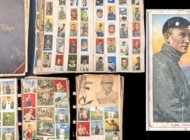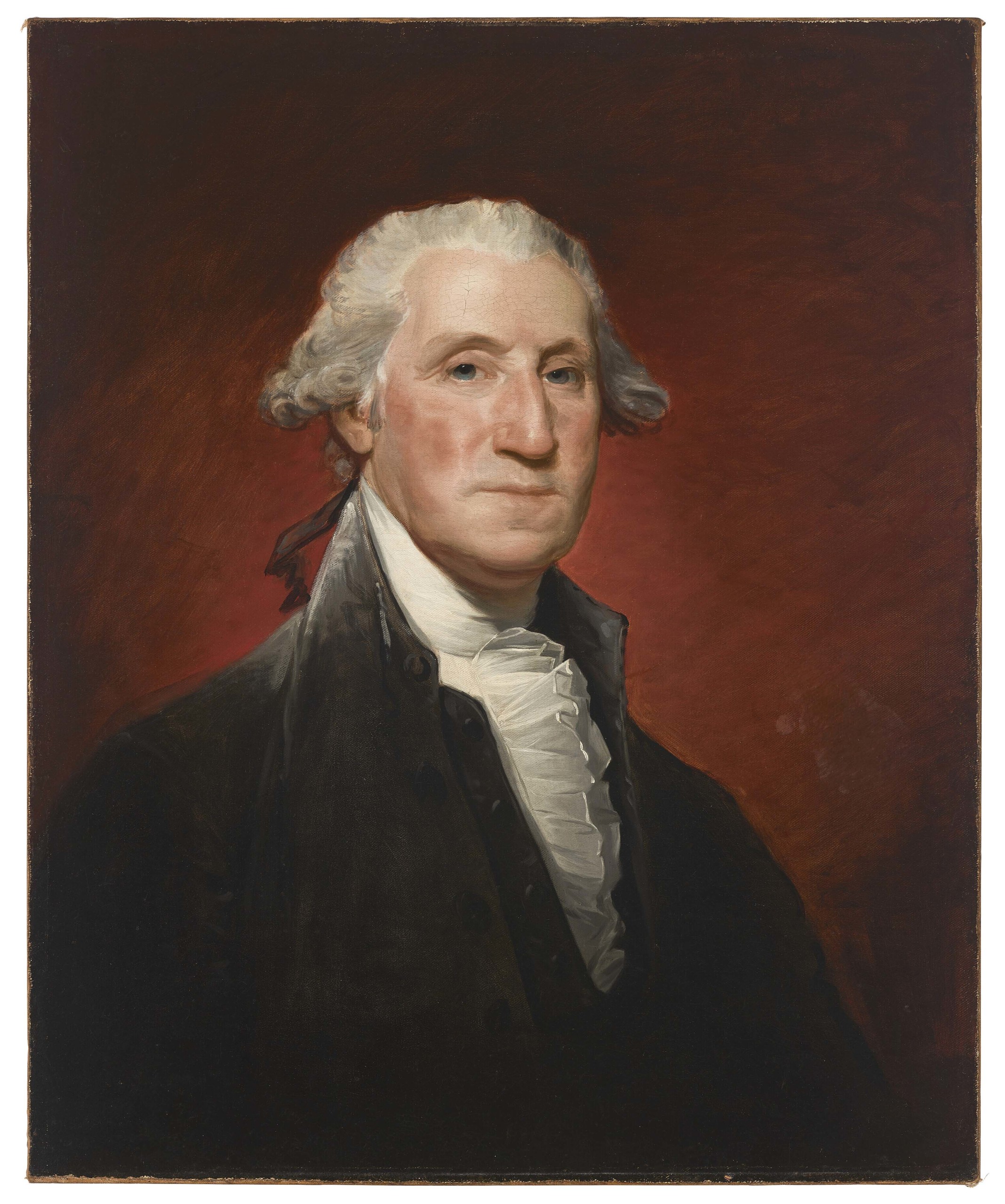
The top lot of the two-day Important Americana sale was this “Vaughan type” portrait of George Washington by Gilbert Stuart, oil on canvas, 29 by 23¾ inches. One of just 14 examples known, with just four in private hands prior to the sale, it was being deaccessioned by the Metropolitan Museum of Art and sold to a collector for $2,833,000 ($1.5/2.5 million).
Review & Onsite Photos by Madelia Hickman Ring; Photos Courtesy Christie’s
NEW YORK CITY — Continuing its longstanding tradition of selling Important Americana — furniture and folk art — in mid-January, Christie’s presented that material alongside silver, Chinese export and prints January 18-19. The firm further expanded its offerings to include fine printed and manuscript Americana on January 17 ($11,146,052), and Nineteenth Century American & Western Art on January 18 ($13,153,212). With the $9,294,784 tallied by the Important Americana sale, Christie’s take for four days of sales was a healthy $33,594,048.
“I was really thrilled at how many people came to both the preview and the sale,” effused Cara Zimmerman, Christie’s head of Americana and Outsider Art. “Things with great history really sang this year and captured the imagination of our buyers. The energy around the Important Americana sale really excited me.” She noted their press office confirmed the impressive statistic that 25 percent of all buyers and bidders were new to the category, showing promising signs of longevity, if not growth.
John Hays, Christie’s deputy chairman who always wields the gavel with aplomb during the firm’s Americana auctions, was also upbeat a couple of days after the sale. “Folk art is resilient, it got lots of interest. The importance of provenance has increased immensely, and people really responded to the ‘story’ of an item. In the era we’re in, when we’re looking more closely at our Founding Fathers, the important contributions George Washington made are still appreciated, and we clearly experienced that.”
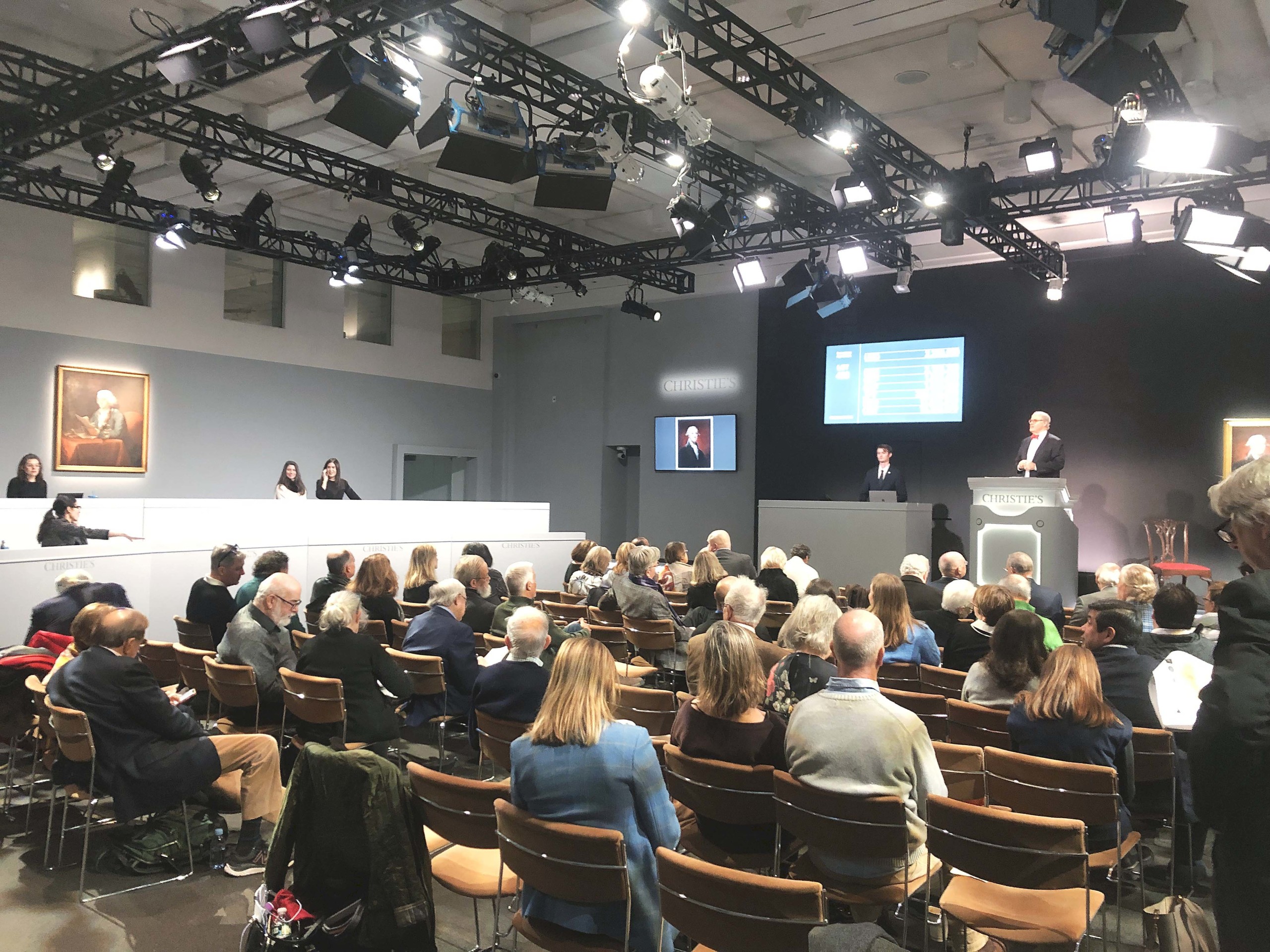
With so much bidding activity taking place online in this post-Covid world, it’s impressive when any auction draws bidders to the salesroom. John Hays is shown here on the podium taking bids for Gilbert Stuart’s portrait of George Washington.
The top lot of the sale was the one Hays referenced and a marquee lot if ever there was one: a “Vaughan type” portrait of George Washington by Gilbert Stuart (1755-1828) that had been painted in 1795, shortly after his first sitting with the artist that same year. According to the catalog, the portrait is just one of 14 known to exist, with many of those in the collections of the National Gallery of Art (which owns two examples), the Metropolitan Museum of Art, the Frick Collection, Winterthur Museum, Colonial Williamsburg, the University of Virginia, Harvard University, Indianapolis University Library. Washington would sit for Stuart again in early 1796 for what would become known as the “Atheneum” portrait, which survive in greater numbers.
The portrait carried a tantalizing history of ownership, firstly with either Nathaniel Philips (1726-1808) or his son, Samuel Philips (1762-1824) of Manchester, England; it remained in the Philips family until 1923 when the Duveen Brothers purchased it. A year later, in 1924, Joseph Duveen sold it to Richard De Wolfe Brixey (1880-1943), who bequeathed it to the Metropolitan Museum of Art upon his death. Since it was painted, the portrait was included in numerous publications and has appeared in exhibitions at four museums, including the Met, since 1932.
Prior to the sale, only four of the other “Vaughan type” portraits were in private hands and the lot carried an estimate of $1.5/2.5 million. Bidding on the painting opened at $950,000 with bidding holding steady until just two phone bidders — both private collectors — remained standing. Hays finally brought the gavel down with a closing bid of $2,833,000, selling to one of the two phone bidders and making it the fifth to be owned privately.
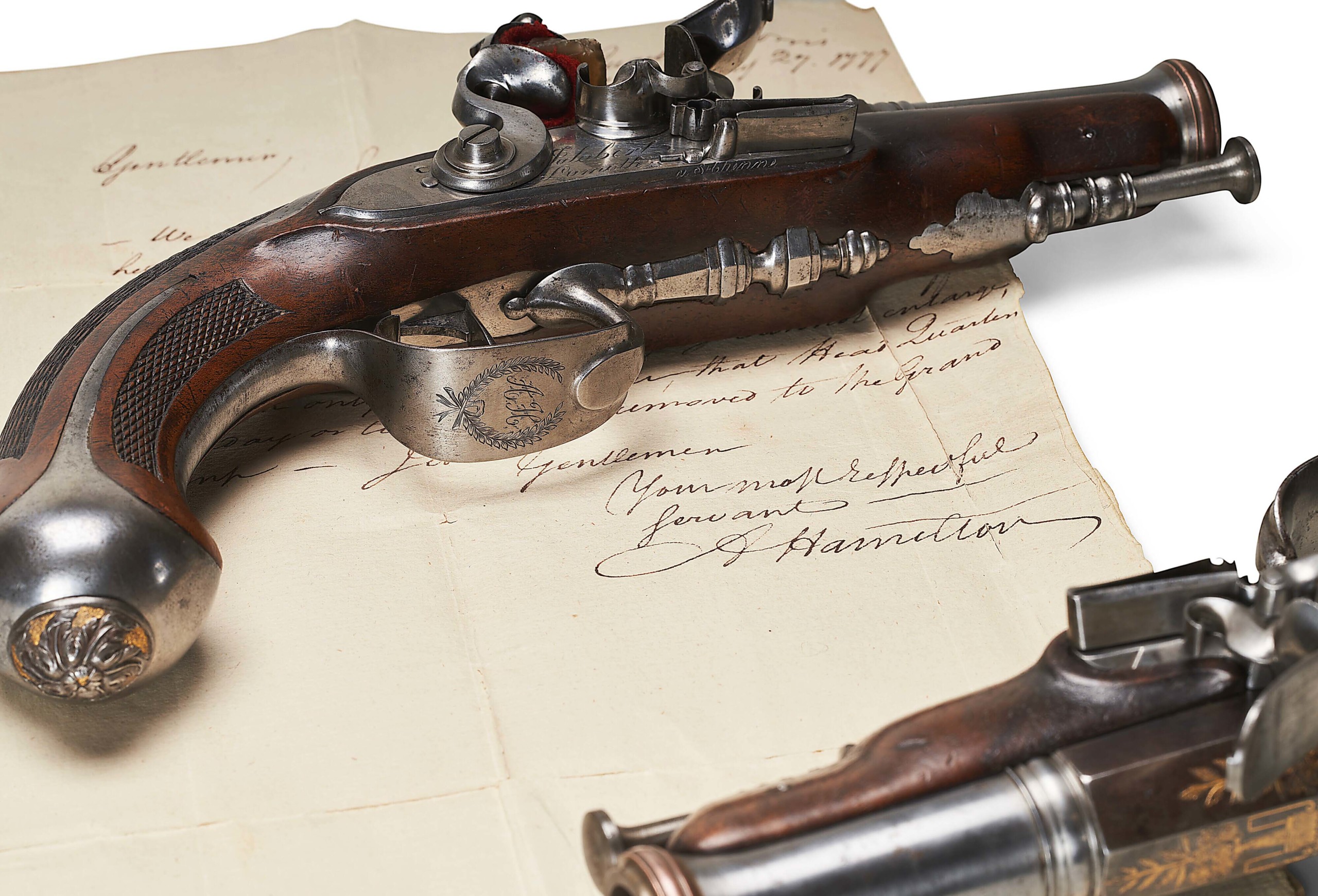
The Metropolitan Museum of Art deaccessioned this pair of flintlock pocket pistols that had been owned by — and descended in the family of — Alexander Hamilton. A phone bidder won the pair for $819,000 (estimate on request).
The painting was not the only lot to be sold by the Metropolitan Museum to benefit their acquisition fund; a pair of flintlock pistols made in Saint Etienne, France, 1798-1804, had descended in the family of General Alexander Hamilton before being purchased by the museum in 1950. Published only as “estimate on request,” bids were accepted at $320,000 and continued until the lot sold at $819,000, to the phone bidder who underbid the Washington portrait. A double-barreled shotgun that had also been made in Saint Etienne and which was owned by Founding Father and US Chief Justice John Jay (1745-1829) sold to an online bidder from Massachusetts for $30,240.
Other institutions were in the mood to sell as well. New York City’s Gilder Lehrman Institute of American history sold a portrait of George Washington by Rembrandt Peale (1778-1860) for $529,000 to a buyer bidding on the phone with ceramics specialist, Carleigh Queenth.
Institutions were not just selling; they were buying as well. Mount Vernon, bidding in the room, purchased a sketch of George Washington, a colossal profile done by Rembrandt Peale after Jean Antoine Houdon (1741-1828), for $52,900. An unidentified institution acquired Ralph Earl’s portraits of Thomas and Anna (Dibble) Tucker for $163,800 and the Columbus Museum of Art in Columbus, Ga., bidding through fine art dealer Betty Krulik, paid $119,700 for John Singleton Copley’s (1738-1815) portrait of Samuel Phillips Savage.
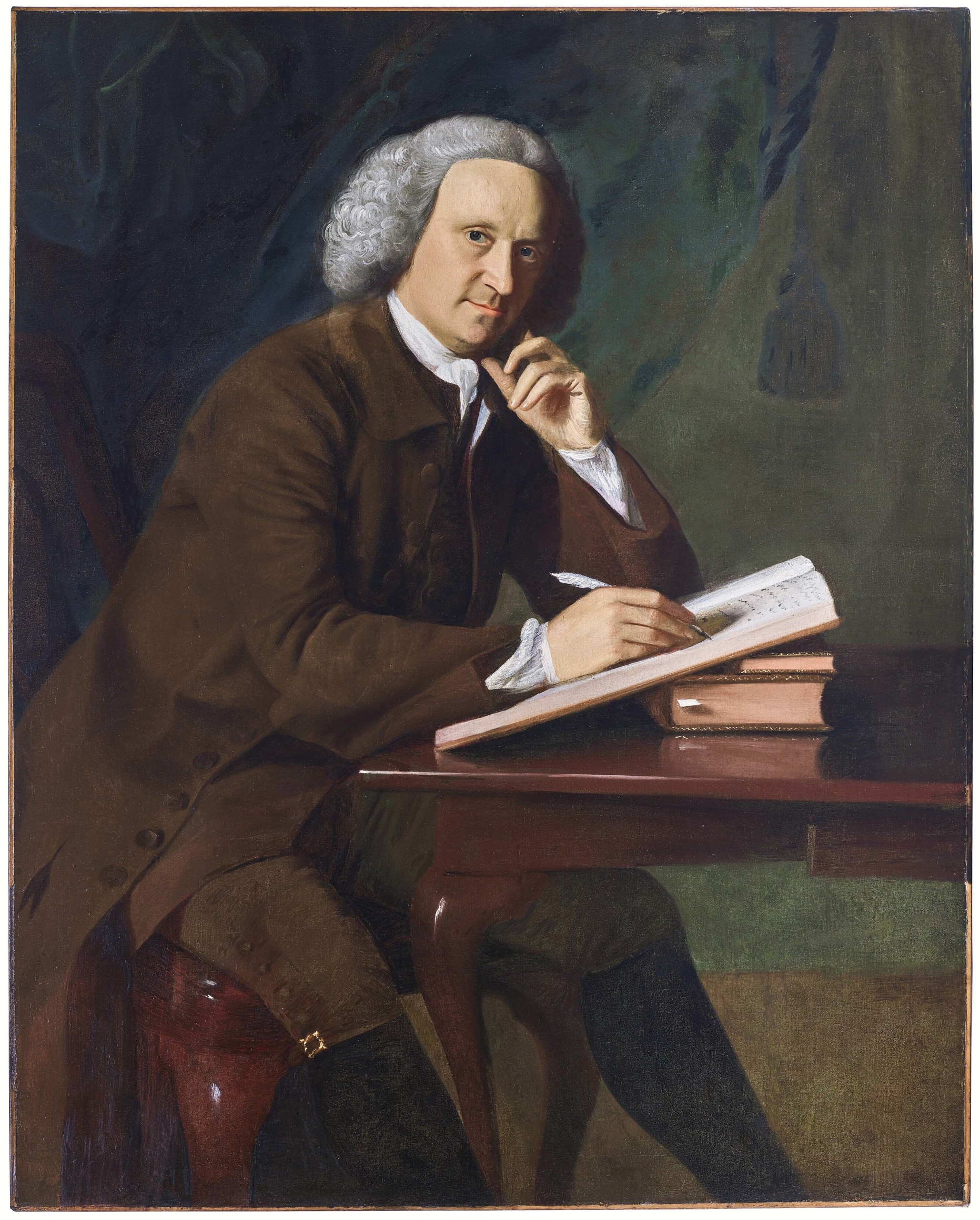
This portrait of Samuel Phillips Savage by John Singleton Copley, signed and dated 1764, oil on canvas, 50 by 40½ inches, had been loaned to the MFA Boston in 1877. It found a new home at the Columbus Museum of Art in Columbus, Ga., for $119,700; art dealer Betty Krulik was bidding on behalf of the museum from the room ($100/150,000).
For several years, works from the Wunsch Collection have been highlights of Christie’s sales and this edition was no exception. Other works with the same provenance, including the Copley portrait mentioned above, saw strong results. Achieving $163,800 was a Chippendale mahogany bombé chest of drawers made in Marblehead, Mass., circa 1700 that had originally belonged to the Crowninshield family. Extensively documented and including both publication and exhibition history, the chest had previously been auctioned in 2014, when it realized $581,000. The same 2014 auction was where the Wunschs’ acquired the Deshler family Chippendale carved mahogany side chair for $725,000; offered in this sale, it brought $126,000 from a trade buyer bidding in the room.
As Hays mentioned, folk art got lots of interest that translated into strong salesroom results. Leading the category with a new world record for the artist at $1,134,000, and well ahead of its estimate of $100/200,000, was “Portrait of Mrs Martha (Hall) Dorsey and MaryAnn Dorsey” by Joshua Johnson (circa 1763-after 1824). Bidders liked that it had never left the family of the sitters and had been published in two works, including a 1987 monograph on the artist by Carolyn J. Weekley and Stiles Colwill. Johnson has enjoyed broad interest from collectors and institutions recently and the result broke the previous world record of $675,000, which had stood since 2019.
Other folk art portraits also did well. A striking portrait of Mrs Ruth (Haynes) Palmer by Ammi Phillips (1788-1865) that had an extensive provenance that included Mr and Mrs Peter H. Tillou and had been off the market since 1985 when it sold at Sotheby’s, brought $201,600 from a trade buyer bidding in the room. A double portrait of a girl in a pink dress and her brother by William Matthew Prior (1806-1873), last seen on the auction market in 1986, sold to another trade buyer, bidding in the room, for $50,400.
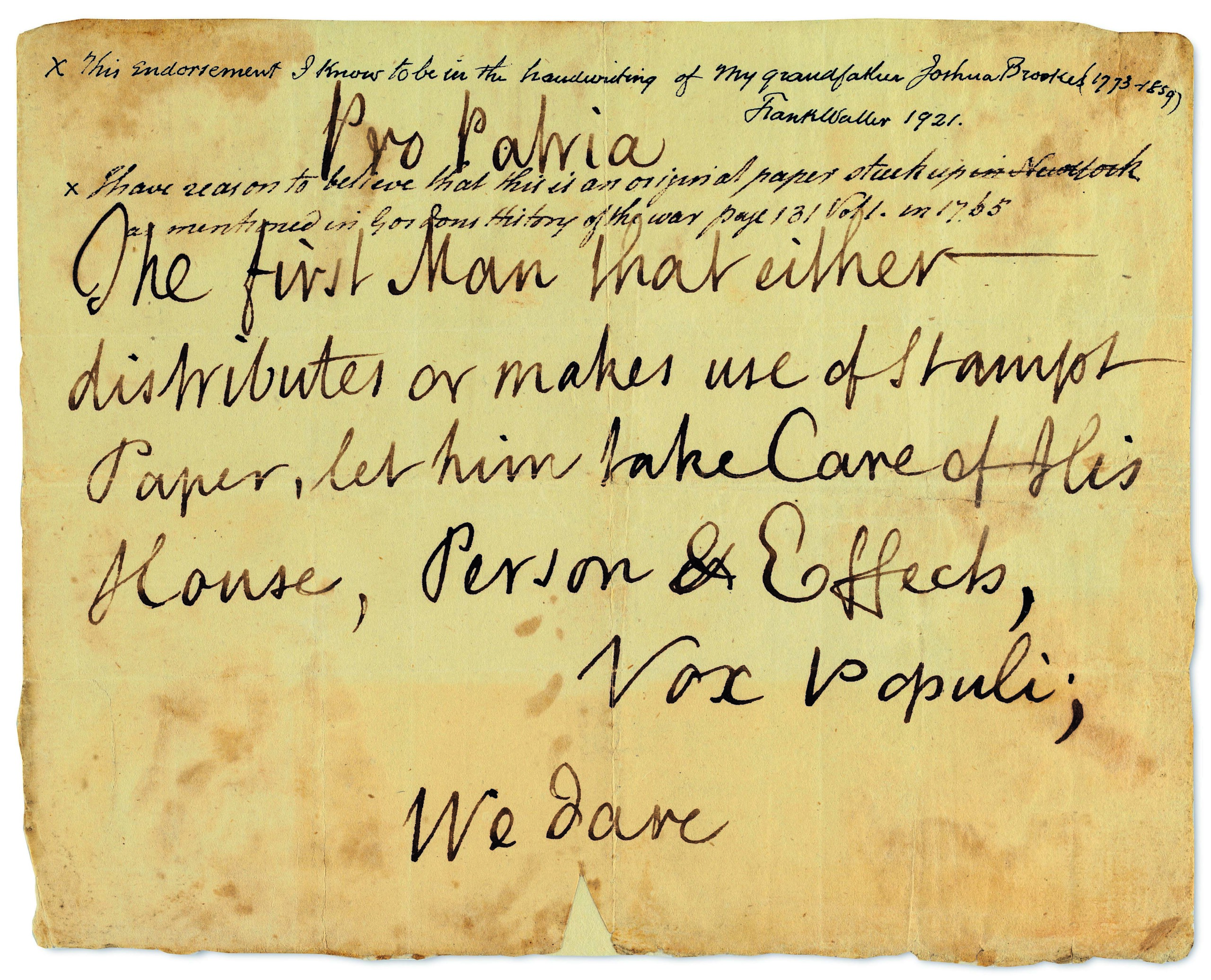
This 6-1/8-by-7½-inch laid paper document — known as the Stamp Act Defiance Placard — is the early known documentary evidence of popular revolt against Great Britain in the American colonies. One of just two examples known, it was the only one in private hands before Christie’s sold it for $4,527,000 ($4/6 million).
Fine Printed & Manuscript Americana
Christie’s Fine Printed and Manuscript Americana auction made a total of $11,145,044, achieving 86 percent sold by lot. More than 15 percent of the buyers and bidders who participated in the sale were new to the category at Christie’s, and 10 percent of buyers were millennials.
The sale was led at $4,527,000 by a document that forecasts the dawn of the American Revolution. The Stamp Act Defiance Placard, dated October 1765, is the earliest known documentary evidence of popular revolt against Great Britain in the American colonies and the first explicit threat of violence in the defense of American liberty. One of two versions of this rare, handwritten document of the American Revolution, it is the only known in private hands.
Other highlights of the sale include documents that illustrate other key moments in American history. The earliest record of Robert E. Lee’s surrender at Appomattox, Va., is the earliest contemporary record of the final exchange of letters that effected the surrender of Robert E. Lee and the Army of Northern Virginia — and the earliest extant copy of Lee’s acceptance of Grant’s terms in any form. Written in the hand of Ely S. Parker, Grant’s chief of staff and a Tonawanda Seneca, bidders chased it to $882,000.

The earliest record of Lee’s surrender on April 9, 1865, in Appomattox, Va., which signaled the conclusion of the Civil War, achieved $882,000 ($600/800,000).
Ernest “Lee” Keet’s family has been in the Adirondack region since 1805. A private equity investor, Keet assembled a superb collection with a special focus on early French and English exploration in the American Northeast, especially in the St Lawrence and Champlain valleys, and on the Adirondacks. Keets and his wife Nancy formed the Cloudsplitter Foundation, dedicated to improving the future for the flora, fauna, communities and people of the Adirondacks. Appropriately, the library which he formed is now being sold on behalf of the Cloudsplitter Foundation and will directly benefit its grantees. The top lot from their collection is the rare and largest map of the first edition of Samuel de Champlain’s “Les Voyages du Sieur de Champlain Xaintongeois”; it found a new home for $1,320,000.
Nineteenth Century American & Western Art
Christie’s annual sale of Nineteenth Century American & Western Art achieved $13,153,212, the largest total for the sale platform since its inception three years ago. The sale was 84 percent sold by lot and more than 15 percent of the buyers and bidders who participated in the sale were new to the category at Christie’s. The auction showed the strength of single-owner collections with important results for works from the Morton and Norma Lee Funger Collection, and the continuing vibrance in the market for images of the West, with Western Masterworks, property from a Distinguished Private Collection.

“Cattleya Orchid with Two Brazilian Hummingbirds” by Martin Johnson Heade, 1871, oil on panel, 13¾ by 18 inches, signed and dated, led the Nineteenth Century American & Western Art sale at $3,438,000 ($1.2/1.8 million).
The top lot of the sale came from the Funger Collection: Martin Johnson Heade’s (1819-1904) “Cattleya Orchid with Two Brazilian Hummingbirds,” an iconic American painting, which realized $3,438,000. Pieces from Western Masterworks also achieved major results, led by Thomas Moran’s (1837-1826) “Afterglow, Green River, Wyo.,” a sweeping canvas from 1918 that made $2,228,000. Other Western Masterworks pieces among the top lots were, James Earl Fraser’s (1876-1953) sculpture, “The End of the Trail,” which brought $1,381,000; and Eanger Irving Couse’s (1866-1936) “Thunder Birds,” achieved $819,000.
Tylee Abbott, Christie’s head of the American art department commented, “Christie’s continues to prove its dedication to the Western American Art field, with breakout prices for truly exceptional examples, including those by Thomas Moran, James Earle Fraser and Eanger Irving Couse. Largely driven by a diverse audience of both established Western Art collectors and clients new to the category, such success points to notable health in this especially American genre.”
Prices quoted include the buyer’s premium as reported by the auction house. For information, www.christies.com.

